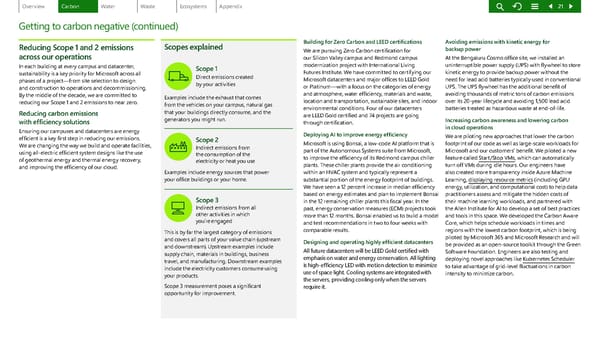Getting to carbon negative (continued) Reducing Scope 1 and 2 emissions across our operations In each building at every campus and datacenter, sustainability is a key priority for Microsoft across all phases of a project—from site selection to design and construction to operations and decommissioning. By the middle of the decade, we are committed to reducing our Scope 1 and 2 emissions to near zero. Reducing carbon emissions with efficiency solutions Ensuring our campuses and datacenters are energy efficient is a key first s tep in reducing our emissions. We are changing the w ay we build and operate facilities, using all-elect ric efficient system designs like the use of geothermal ene rgy and thermal energy recovery, and improving th e efficiency of our cloud. Scopes explained Scope 1 Direct emissions created by your activities Examples include the exhaust that comes from the vehicles on your campus, natural gas that your buildings directly consume, and the generators you might run. Scope 2 Indirect emissions from the consumption of the electricity or heat you use Examples include energy sources that power your office buildings or your home. Scope 3 Indirect emissions from all other activities in which you ́re engaged This is by far the largest category of emissions and covers all parts of your value chain (upstream and downstream). Upstream examples include supply chain, materials in buildings, business travel, and manufacturing. Downstream examples include the electricity customers consume using your products. Scope 3 measurement poses a significant opportunity for improvement. Building for Zero C arbon and LEED certifications We are pursuing Z ero Carbon certification for our Silicon Val ley campus and Redmond campus modernization project with International Living Futures Institute. We have committed to certifying our Microsoft dat acenters and major offices to LEED Gold or Platinum—wi th a focus on the categories of energy and atmospher e, water efficiency, materials and waste, location and t ransportation, sustainable sites, and indoor environmental conditions. Four of our datacenters are LEED Gold cer tified and 74 projects are going through certification. Deploying AI to im prove energy efficiency Microsoft is usi ng Bonsai, a low-code AI platform that is part of the Autonomous Systems suite from Microsoft, to improve the ef ficiency of its Redmond campus chiller plants. These ch iller plants provide the air conditioning within an HVAC system and typically represent a substantial portion of the energy footprint of buildings. We have seen a 12 per cent increase in median efficiency based on energy e stimates and plan to implement Bonsai in the 12 remain ing chiller plants this fiscal year. In the past, energy co nservation measures (ECM) projects took more than 12 months. Bonsai enabled us to build a model and test recommendations in two to four weeks with comparable results. Designing and op erating highly efficient datacenters All future datacenters will be LEED Gold certified with emphasis on water and energy conservation. All lighting is high-efficiency LED with motion detection to minimize use of space light. Cooling systems are integrated with the servers, providing cooling only when the servers require it. 21 Avoiding emissions with kinetic energy for backup power At the Bengaluru C osmo office site, we installed an uninterruptible power supply (UPS) with flywheel to store kinetic energ y to provide backup power without the need for lead acid batteries typically used in conventional UPS. The UPS flywh eel has the additional benefit of avoiding thous ands of metric tons of carbon emissions over its 20-year lifecycle and avoiding 1,500 lead acid batteries treated as hazardous waste at end-of-life. Increasing ca rbon awareness and lowering carbon in cloud operations We are piloting n ew approaches that lower the carbon footprint of our code as well as large-scale workloads for Microsoft and o ur customers’ benefit. We piloted a new feature calle d Start/Stop VM s , which can automa tically turn off VMs during idle hours. Our engineers have also created more transparency inside Azure Machine Learning, displaying reso urce metrics (including GPU e nergy, utilization, and computational cost) to help data practitioners assess and mitigate the hidden costs of their machine learning workloads, and partnered with the Allen Institute for AI to develop a set of best practices and tools in this space. We developed the Carbon Aware Core, which helps schedule workloads in times and regions with the lowest carbon footprint, which is being piloted by Microsoft 365 and Microsoft Research and will be provided as an open-source toolkit through the Green Software Foundation. Engineers are also testing and deploying novel approaches like Kubernetes Sche duler to take advanta ge of grid-level fluctuations in carbon intensity to mi nimize carbon.
 Environmental Sustainability Report | Microsoft Page 20 Page 22
Environmental Sustainability Report | Microsoft Page 20 Page 22